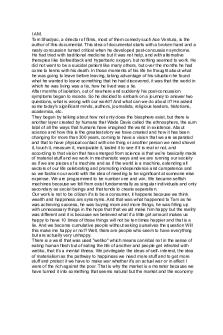I am not your negro reflection PDF

| Title | I am not your negro reflection |
|---|---|
| Course | Modern History |
| Institution | College of Charleston |
| Pages | 2 |
| File Size | 77.2 KB |
| File Type | |
| Total Downloads | 62 |
| Total Views | 137 |
Summary
Reflection paper dr. slater...
Description
Reflective Essay: I Am Not Your Negro African Americans may have became free from slavery in 1865 with the passage of the 13th amendment however, in the 1950s they were still in a sense ‘slaves’. The American Culture in the 1950s and 1960s reading explains that after World War II life in America was prosperous and exciting. People were buying big cars, enjoyed drive-in cinemas, purchased television sets, and women hosted Tupperware parties while the dads came home from work to throw the ball around with kids. Yet it also explains how World War II had made America ripe for a social revolution. The section of the reading entitled White and Black, Apart and Together points out how, “As had always been the case, peace and prosperity for some did not mean peace and prosperity for all.” This was most certainly the case and is highlighted in James Baldwin’s documentary I Am Not Your Negro. The documentary shows African American history that connects the Civil Rights movement of the mid 20th century to the present Black Lives Matter movement. It questions black representation in Hollywood as well as many other aspects of society. The films inspiration comes from Baldwin’s unfinished manuscript, Remember This House, in which he recounts his memories and experiences he had with civil rights leaders Medgar Evers, Malcolm X, and Dr. Martin Luther King Jr. This documentary brilliantly demonstrates Baldwin’s ability to show the ways anti-black sentiment established America’s social and political life but also its cultural imagination. The continuing racial dilemma in American society is powerfully shown thru connecting clips of Evers, Malcolm X, and Dr. King's speeches and funerals to clips of present day police brutalities and marches that are happening all across the country. Baldwin perfectly illustrates the race issue in America with one simple line that can leave the reader or listener with
a thought to ponder, "not everything that is faced can be changed, but nothing can be changed if it is not faced."
Reflection: I found this documentary to be probably one of the most powerful and eye-opening films I have ever watched. One line that really stood out to me was when Baldwin writes how a black man wants white people out of their lives because of anger while white men want black men out of their lives because of fear. I am in no way, shape, or form a racist but I somehow related to this with a personal experience of when I was in an uber one time on my way to a doctor's appointment alone and my driver was a young black man. For some reason I felt somewhat anxious and fearful and just wanted it to be a quick drive, and I thought to myself “Why do I feel like this? Would I feel like this if it was a young white man?” This film really made me ask myself why I felt like that and how stupid it was of me to have those feelings. I believe the way the media and news sources portray African Americans still needs to fixed now and I really had no idea how many difficulties they still face today. This film is extremely powerful through its words and images and I am very grateful to have been able to watch it....
Similar Free PDFs

I am not your negro reflection
- 2 Pages

I AM SAM Movie Reflection
- 2 Pages

TV I\'m... I\'m not...Am I...
- 4 Pages

Ensayo I AM SAM
- 3 Pages
![[Template] Who am I](https://pdfedu.com/img/crop/172x258/6n3e9lyvq625.jpg)
[Template] Who am I
- 2 Pages

I am a rock - Poem
- 1 Pages
Popular Institutions
- Tinajero National High School - Annex
- Politeknik Caltex Riau
- Yokohama City University
- SGT University
- University of Al-Qadisiyah
- Divine Word College of Vigan
- Techniek College Rotterdam
- Universidade de Santiago
- Universiti Teknologi MARA Cawangan Johor Kampus Pasir Gudang
- Poltekkes Kemenkes Yogyakarta
- Baguio City National High School
- Colegio san marcos
- preparatoria uno
- Centro de Bachillerato Tecnológico Industrial y de Servicios No. 107
- Dalian Maritime University
- Quang Trung Secondary School
- Colegio Tecnológico en Informática
- Corporación Regional de Educación Superior
- Grupo CEDVA
- Dar Al Uloom University
- Centro de Estudios Preuniversitarios de la Universidad Nacional de Ingeniería
- 上智大学
- Aakash International School, Nuna Majara
- San Felipe Neri Catholic School
- Kang Chiao International School - New Taipei City
- Misamis Occidental National High School
- Institución Educativa Escuela Normal Juan Ladrilleros
- Kolehiyo ng Pantukan
- Batanes State College
- Instituto Continental
- Sekolah Menengah Kejuruan Kesehatan Kaltara (Tarakan)
- Colegio de La Inmaculada Concepcion - Cebu









